Irish potato bread, or farls, is a staple everyone should know how to cook. Simple to make using only four ingredients, potato, flour, butter, and salt. They are the perfect accompaniment to an Ulster Fry (Irish Breakfast).

I learnt how to make potato bread from my late Irish mother-in-law. It has been a staple in our household for over three decades. I warn you, once you start making this simple bread you will be hooked.
Not a light and fluffy loaf of bread, they are flat and fried. More like potato pancakes or pan-fried flatbread. They are addictive and delicious. When I make a batch, they disappear a little too quickly.
Sara xxx
Ingredients

You will see below that I use what I have on hand to make this recipe. It isn't a fussy recipe, or hard to make, and there is wiggle room regarding recipe execution.
- Plain White Flour: Plain old white flour, not self-raising. You could use 00 flour, spelt, or wholemeal if you wish.
- Unsalted or Salted Butter: I use whatever I have on hand. If you do use salted butter don't add the salt from the ingredient list. You will also need some extra butter to fry these beauties in.
- Potatoes: I am not precious about the potatoes I use in this recipe, it really doesn't matter. Again it is a case of whatever potatoes happen to be in the pantry at the time.
- Salt: Just a pinch of salt for flavour, omit if you are using salted butter
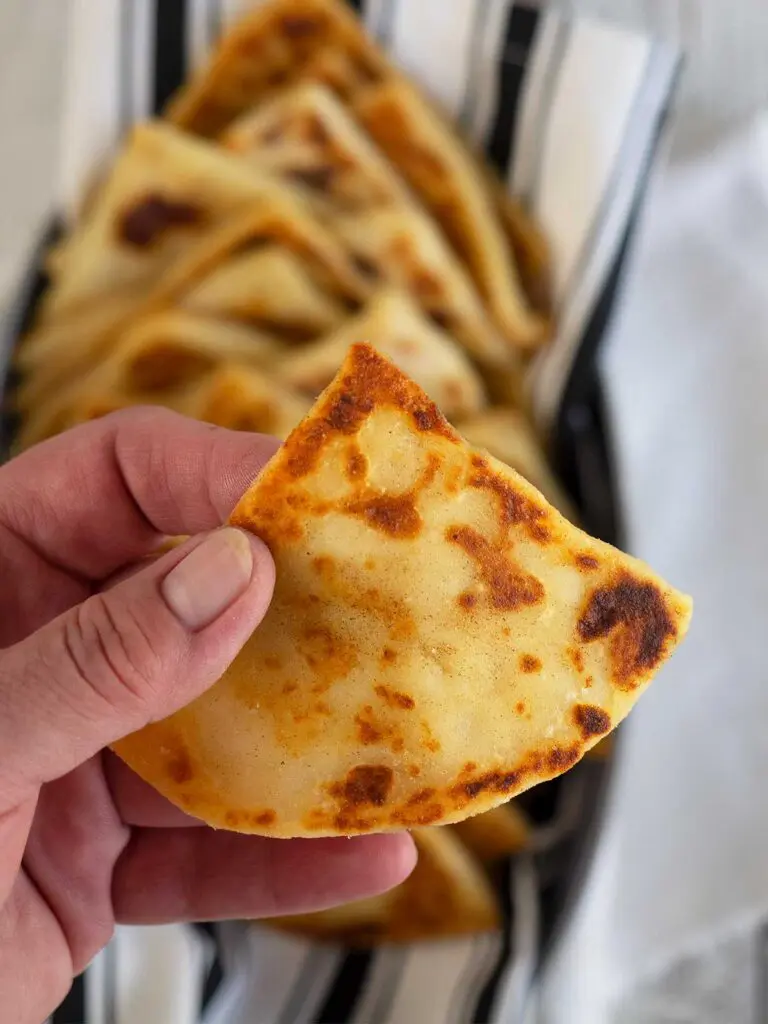
Recipe Variations
The great thing about this recipe is you can jazz it up a little if you want. Change the shape, thickness, even add some extra ingredients.
The Shape
You can see from the photos that I make my Irish potato bread on the thin side. Of course you can make it thicker if you desire. Half a centimeter or just under a quarter of an inch is my optimal thickness as an accompaniment to a breakfast fry up. At that thickness, they will mop up runny egg yolks magically.
Instead of rolling out balls and cutting them into quarters save time and roll out two larger oblongs of dough. Then cut into desired-sized squarish pieces. Or get the kids involved and use cookie cutters and cut out fun shapes.
Flavour Enhancers
I tend to not jazz my Irish potato bread up too much. Simply as I like the taste as they are. Saying that, the dough is a great base recipe to jazz up with some flavour tweaks.
- Cheese: A hand full of your favourite grated cheese mixed into the dough for some cheesy goodness.
- Cheese & Onion: Sauté some white onion in butter until it is soft and translucent and allow the mixture to cool. Mix in with the cheese and other ingredients.
- Fresh Herbs: Add a couple of tablespoons of finely chopped fresh herbs. I personally like chives, thyme, dill, or oregano.
- Bacon: Finely chop a rasher of bacon, fry in a non-stick pan over medium heat until some of the fat has rendered, but bacon has not crisped. Leave to cool and add to ingredients.
- Spinach: Does a green St Patrick's Day version interest you? Defrost a couple of frozen spinach portions (the ones that look like they were made in ice cube trays) and whizz up in a blender (don't squeeze out the liquid). Add to the other ingredients, and add extra flour until the dough is manageable and not too sticky.
- Zucchini: Finely grate a medium zucchini and add to the other ingredients. Make sure to squeeze the excess water from the zucchini first.
- Sweet Potato: Swap the potatoes for sweet potatoes.
- Flavoured Butter: If you have flavoured butter on hand, eg, garlic or truffle, substitute the butter quantity with flavoured butter.
- Cinnamon Sugar: Oh yes, this works just a little too well. Give the cooked bread a decent sprinkle of cinnamon sugar for a sweet version of this recipe.
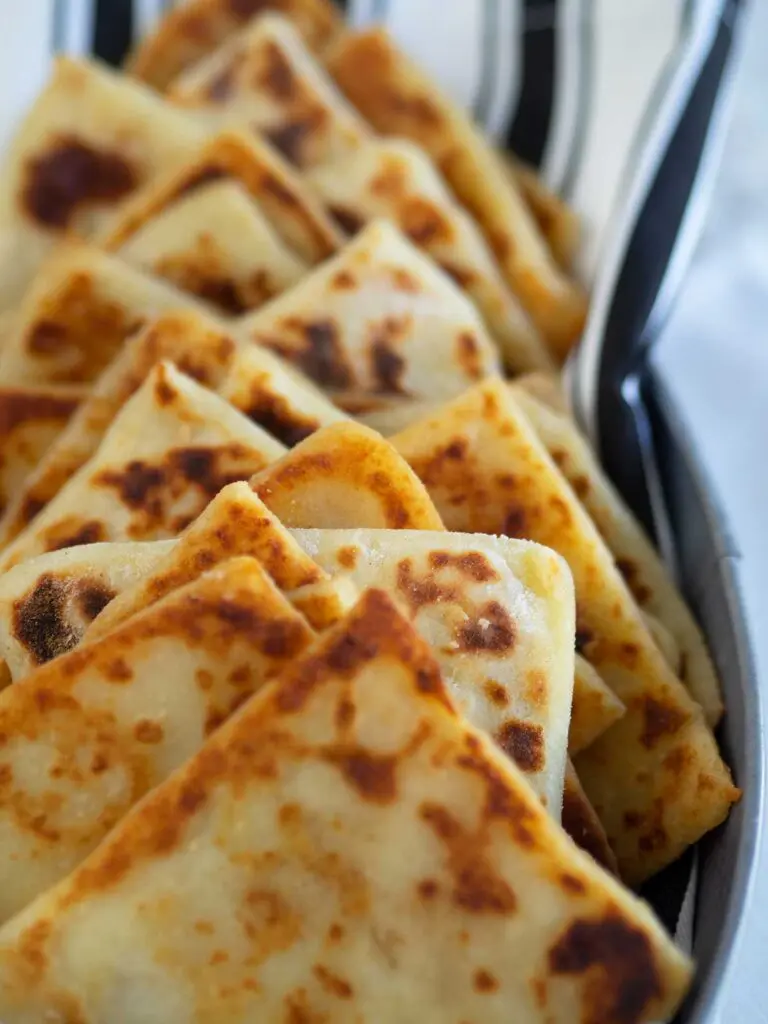
Recipe Walk Through

Peel and cut potatoes into quarters or large chunks. Add to a large pot of cold water.
Bring potatoes to the boil, then reduce to a hard simmer. Cook potatoes until they are tender and cooked through.
Strain potatoes into a colander and leave to cool.
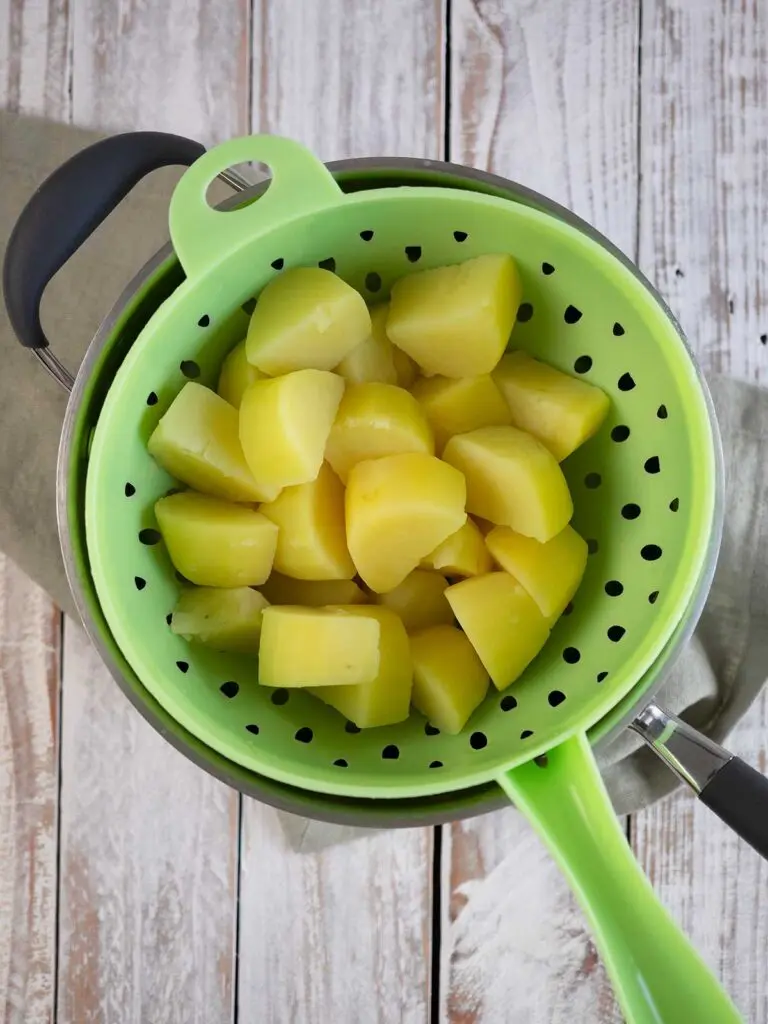
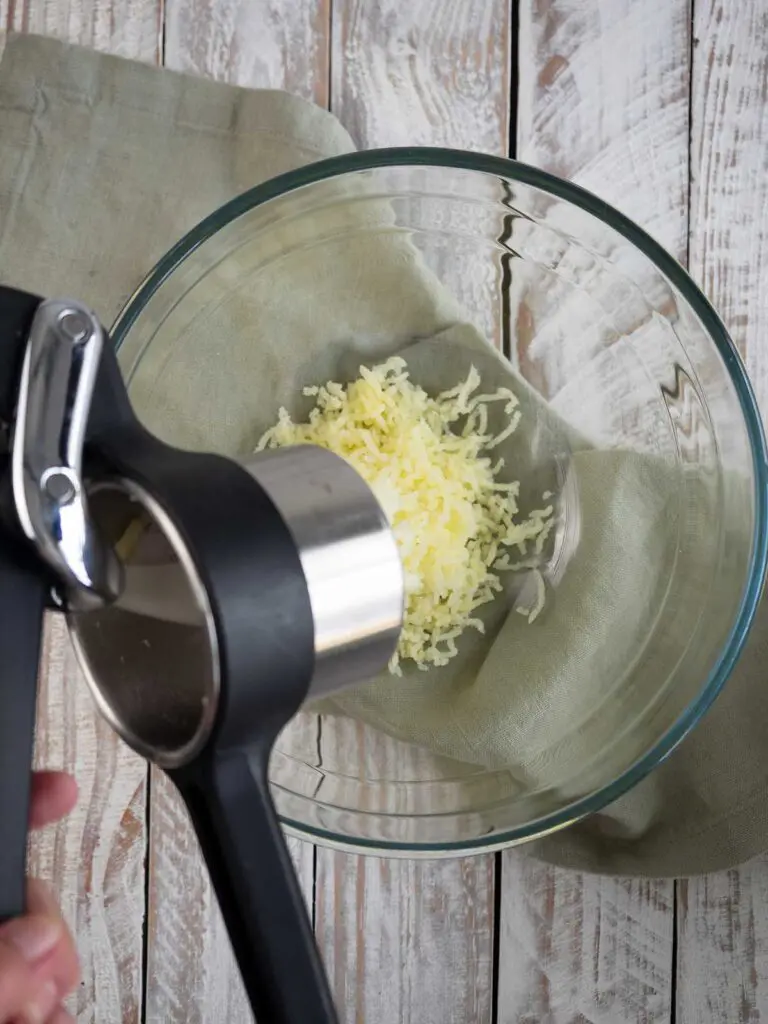
When the potatoes are cool enough to handle place in a potato ricer and rice/mash your potatoes into a large bowl.
I highly recommend this potato ricer with interchangeable mashing discs.
Alternatively use a potato masher and mash well making sure there are no lumps.
Add the remaining ingredients to the bowl.
If you are adding extra ingredients to spruce your Irish potato bread up, now is the time to do so. Further information above or in the recipe card's note section.


Using a spoon mix ingredients together until it becomes difficult to keep mixing.
Continue mixing the dough in the bowl with your hands.
Check for dough consistency.
If you find your dough a little too sticky to handle, add some more flour to make it manageable.
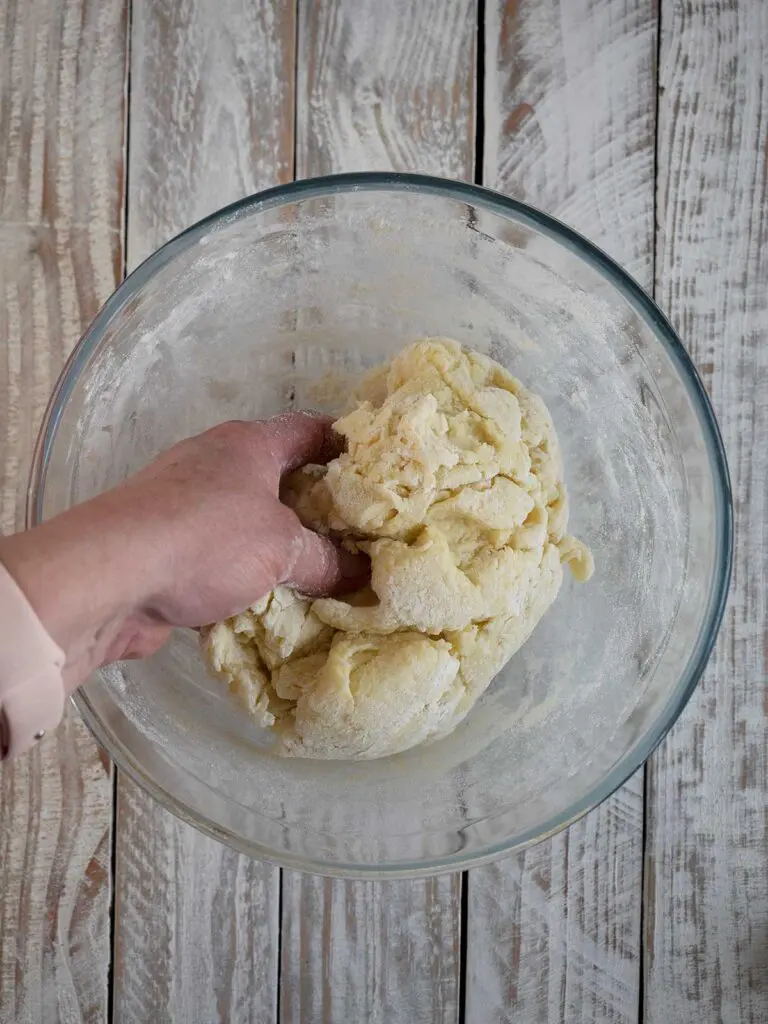

Remove dough from bowl and place on a lightly floured surface. Give it a quick knead until smooth.
If you still find the dough a little too sticky add some more flour while kneading.
The dough is on the sticky side, but should be manageable with flour dusted hands.
Divide the dough into six equal portions and shape into balls.
Working one at a time place a ball of dough on a lightly floured surface.
You can use a clean kitchen bench, or wooden board that has been covered with some baking paper.
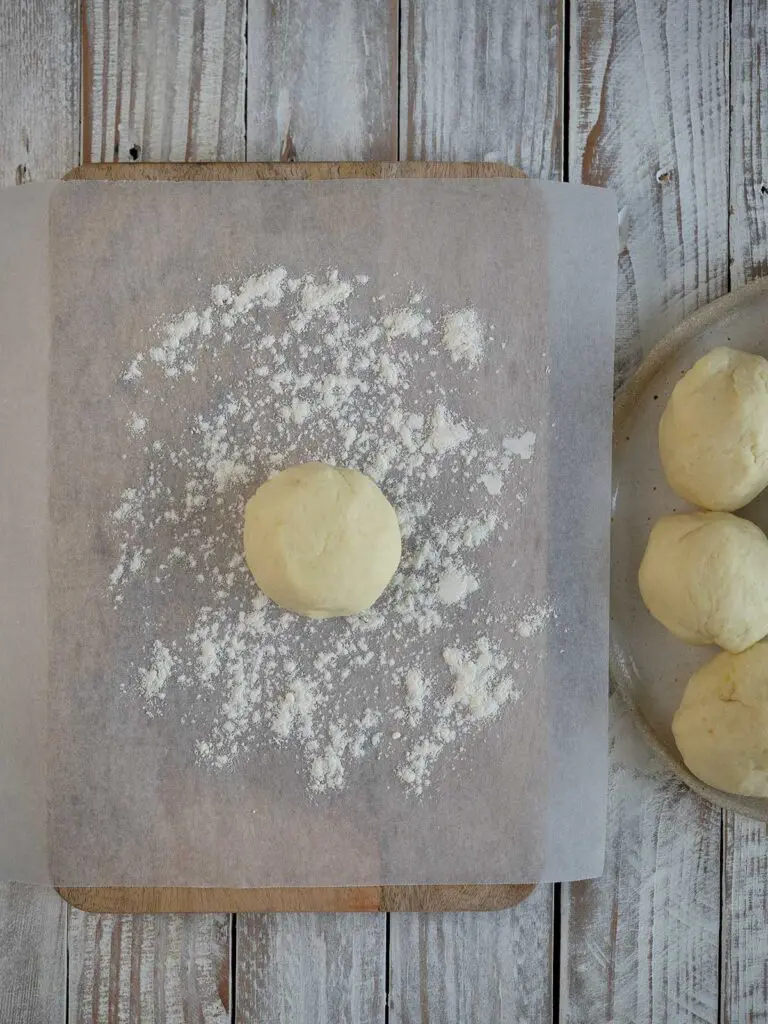
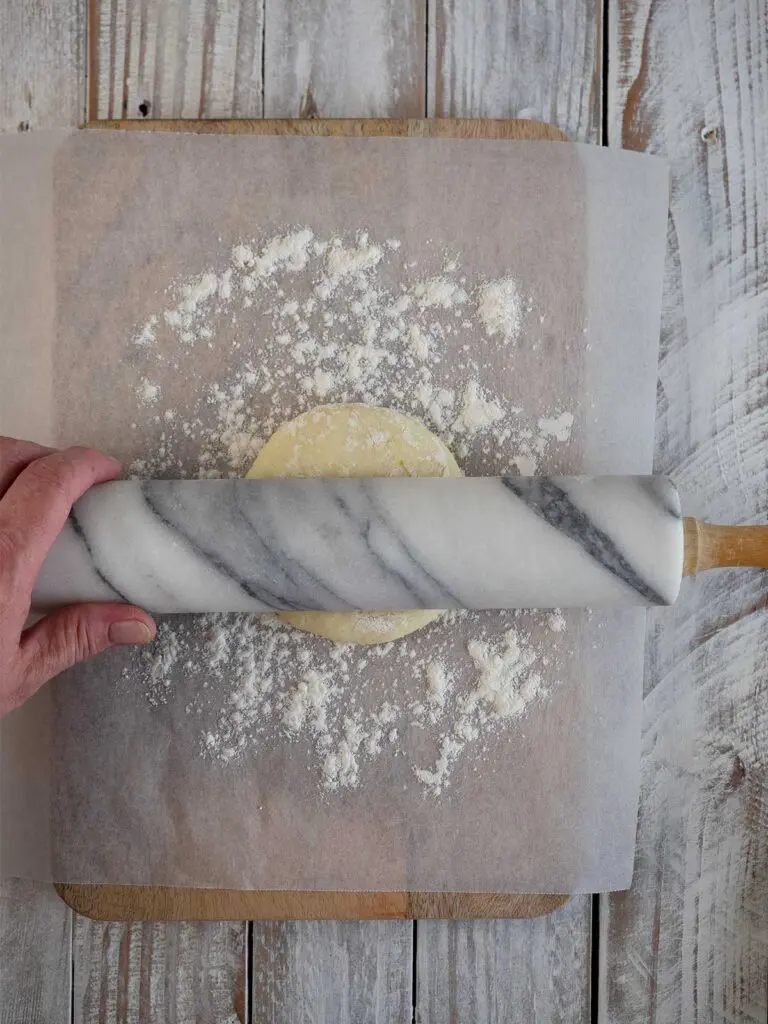
Lightly flour a rolling pin and roll out the dough ball to the desired thickness.
3mm (one eight of an inch) for thin, or half a centimeter (just under a quarter of an inch) for thicker bread.
Cut the rolled out dough into quarters.
Alternatively you can cook them whole for larger pieces of Irish potato bread.

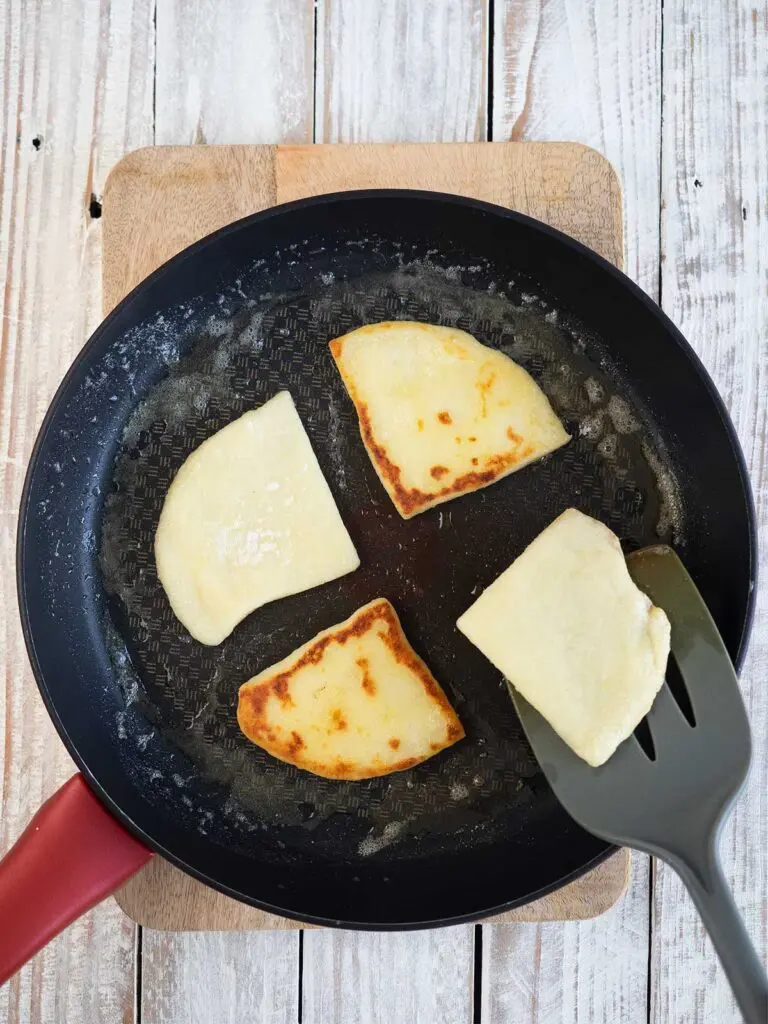
Place a non-stick fry pan over medium heat. Add a splash of olive oil and dollop of butter.
Once the butter has melted add pieces of dough to the pan.
Fry on one side until golden, then turn them over with a spatular. Once the other side is golden and the bread is cooked through remove from the pan.
Place the cooked Irish potato bread on a tray in the oven on low heat to keep warm. Make sure to cover the bread with aluminium foil to stop them from drying out while cooking the remainder of the bread.

Printable Recipe

Irish Potato Bread (Irish Farls)
Ingredients
- 750 grams (1.65 lbs) potatoes
- 30 grams (6 teaspoons) butter | melted
- 225 grams (1 ½ cups) plain flour
- good pinch o salt | omit if using salted butter
- extra butter and olive oil to fry
Instructions
- Peel and cut potatoes into quarters or large chunks. Add to a large pot of cold water.Bring potatoes to the boil, then reduce to a hard simmer. Cook potatoes until they are tender and cooked through.
- Strain potatoes into a colander and leave to cool.
- When the potatoes are cool enough to handle place in a potato ricer and rice/mash your potatoes into a large bowl.Alternatively use a potato masher and mash well making sure there are no lumps.
- Add the remaining ingredients to the bowl.If you are adding extra ingredients to spruce your Irish potato bread up, now is the time to do so. Further information above or in the recipe card's note section.
- Using a spoon mix ingredients together until it becomes difficult to keep mixing.
- Continue mixing the dough in the bowl with your hands.Check for dough consistency.If you find your dough a little too sticky to handle, add some more flour to make it manageable.
- Remove dough from bowl and place on a lightly floured surface. Give it a quick knead until smooth.If you still find the dough a little too sticky add some more flour while kneading.The dough is on the sticky side, but should be manageable with flour dusted hands.Divide the dough into six equal portions and shape into balls.
- Working one at a time place a ball of dough on a lightly floured surface.You can use a clean kitchen bench, or wooden board that has been covered with some baking paper.
- Lightly flour a rolling pin and roll out the dough ball to the desired thickness.3mm (one eighth of an inch) for thin, or half a centimeter (just under a quarter of an inch) for thicker bread.
- Cut the rolled out dough into quarters.Alternatively, you can cook them whole for larger pieces of Irish potato bread.
- Place a non-stick frypan over medium heat. Add a splash of olive oil and a dollop of butter.Once the butter has melted add pieces of dough to the pan.Fry on one side until golden, then turn them over with a spatular. Once the other side is golden and the bread is cooked through remove from the pan.
- Place the cooked Irish potato bread on a tray in the oven on low heat to keep warm. Make sure to cover the bread with aluminium foil to stop them from drying out. Continue cooking the rest of the dough. Add more butter and oil to the pan as needed.
Oven Temperatures
All oven temperatures are fan forced.
Measurement Notes
All measurements are Australian metric standard. All measures are level, and cups are lightly packed unless specified. 1 teaspoon = 5ml / 1 tablespoon = 20mls / 1 cup = 250ml /4 teaspoons = 1 tablespoon.
Recipe Notes
- Cheese: A hand full of your favourite grated cheese mixed into the dough for some cheesy goodness.
- Cheese & Onion: Sauté some white onion in butter until it is soft and translucent and allow the mixture to cool. Mix in with the cheese and other ingredients.
- Fresh Herbs: Add a couple of tablespoons of finely chopped fresh herbs. I personally like chives, thyme, dill, or oregano.
- Bacon: Finely chop a rasher of bacon, fry in a non-stick pan over medium heat until some of the fat has rendered, but bacon has not crisped. Leave to cool and add to ingredients.
- Spinach: Does a green St Patrick's Day version interest you? Defrost a couple of frozen spinach portions (the ones that look like they were made in ice cube trays) and whizz up in a blender (don't squeeze out the liquid). Add to the other ingredients, and add extra flour until the dough is manageable and not too sticky.
- Zucchini: Finely grate a medium zucchini and add to the other ingredients. Make sure to squeeze the excess water from the zucchini first.
- Sweet Potato: Swap the potatoes for sweet potatoes.
- Flavoured Butter: If you have flavoured butter on hand, eg, garlic or truffle, substitute the butter quantity with flavoured butter.
- Cinnamon Sugar: Oh yes, this works just a little too well. Give the cooked bread a decent sprinkle of cinnamon sugar for a sweet version of this recipe.
- 1 teaspoon equals 5ml
- 1 tablespoon equals 20 ml (Nth America, NZ & UK use 15ml tablespoons)
- 1 cup equals 250ml (Nth America use 237ml)
- 4 teaspoons equals 1 tablespoon
- I use the below unless specified in my recipes;
NUTRITIONAL INFORMATION
The recipe's nutritional information is an approximation based on an online calculator. It is meant solely for reference purposes. If you're looking for precise details, be sure to double-check with your own research.
More Family Favourite Recipes
My recipes are like my children, I love them all. But just like kids, you DO have favourites. Some of mine are below including my corned beef recipe and piragi (Latvian bacon buns).


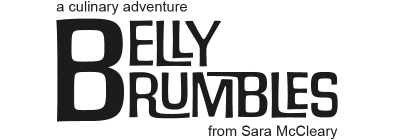

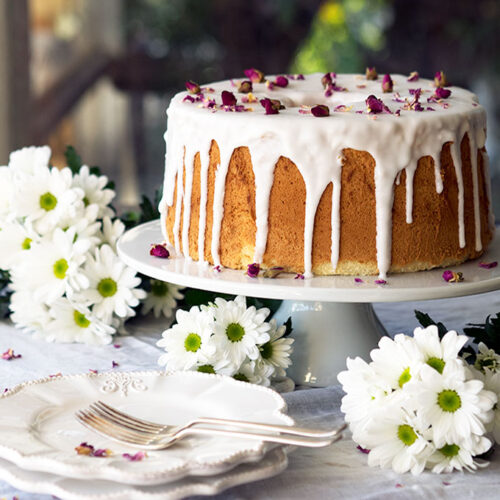
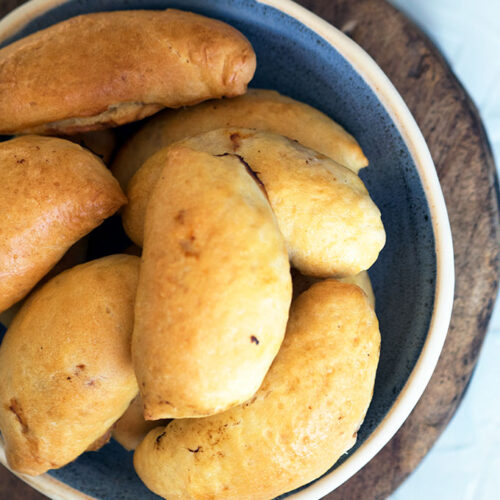

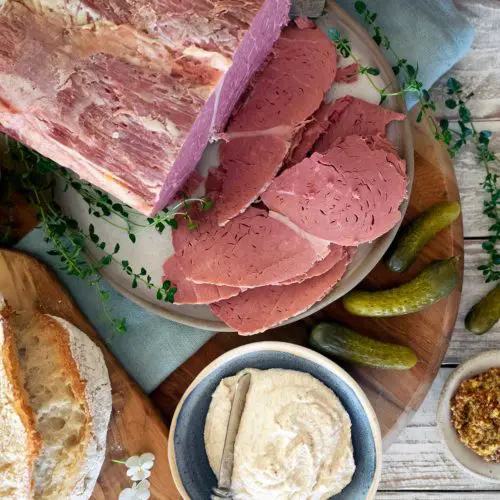
Mary
Hello!
My mother in Ireland made these at least a half inch high ,cooked in the pan as you directed.
Then when needed them for tea time or for breakfast, she cut the thickness horizontally, like you would a bagel, ( now a quarter inch high) and fried again on the pan.
Definitely a superior taste, but of course it needs planning ahead, as the potato bread needs to be cold, post the first fry, to slice without breaking.
Butter for sure in the pan.
Made this recipe today with my daughter in North Carolina US, as she is wrapping gifts and the little kiddies are napping. ?
Happy holidays to all
Sara McCleary
Hi Mary
Thank you for dropping in and sharing your history with potato bread. I love reading everyone's history and experience.
I do really like the method your mother used. I will need to give that a go. Make sure I plan ahead 🙂
Cheers, Sara
K Hall
If you are not going to use the potato farls immediately, then cook on a DRY heavy iron pan or griddle at medium/low heat until each side is slightly coloured. Cool spaced out on a wire rack. Will keep wrapped in fridge for a few days. Fry with oil/butter as needed.
Sara McCleary
Hi K
That is a great tip.
Cheers, Sara
Natasha
How long does this bread last??
My daughter has requested we represent her grandad (my dad) at the foods of the world day at her school. We fell in love with this recipe so want to share it. However I'm wondering when is the best time to make it as the morning of the day with 3 kids is going to be crazy already.
Sara McCleary
Hi Natasha
Love that you are making the potato bread for your daughter's world day at school. You can make them the night before. Of course they are never the same as freshly cooked, but they are still really scrumptious. I would make them a little thicker than what you see in the blog post pictures. Just to keep them a little fluffier.
Hope they are a hit, Cheers, Sara
Peter
I just use the leftovers when making champ (mashed potato with scallions) just add flour and fry done
Ann Monerasinghe
I tried these today, so tasty. Thanks for the recipe
Ann
Gaz
G'day Sara ya recipe was a rippa!!!! made a batch and divided it up Plain, Spicy and with herbs. definitely gonna make it again and play with variations.
I reckon its gonna replace toast with me poached eggs and avo.
Sara McCleary
Hey Gaz
So glad to hear you really enjoyed the recipe. Love the spicy twist.
Cheers, Sara
Roxann
Going to have to try making this. It's very similar to Scandinavian Lefse. Except we add cream or milk to it and roll it as thin as possible, the fry it on a large round electric griddle. This would be much easier to do.
Sara McCleary
Hi Roxann
I hope you enjoy the potato bread when you try it. I must admit I really love the sound of Lefse and will be giving that a try in the not too distant future.
Cheers, Sara
Andy
Hi Sara, my wife loves potato bread for breakfast with a runny yolk on top! It is difficult to find in some shops though and would to make my own. Question is, once cut into shape, can they be frozen before cooking? Thanks Sara great site.
Sara McCleary
Hi Andy
Love a runny yolk and potato bread!!
I've never tried freezing them prior to cooking. In theory I can't see why not.
Just be aware that they will stick together if not separated by some baking paper when freezing.
I would then allow them to de-frost in the fridge before cooking.
Let me know how you go.
Cheers, Sara
Rhonda Boyle
Hi Carol,
I make a recipe pretty similar to this. When I have leftover mashed potatoes, I just add an egg,a little flour, salt, chives, and cheese. The mixture is a little sticky but I spoon it into the pan with melted butter and fry it on medium heat. I was excited to see that it was
an actual recipe. My husband and family love them. I always make soft eggs with them.
Mata
Could you use leftover mashed potatoes that have been refrigerated!
Sara McCleary
Hi Mata,
Yes you can. It is the perfect way to use up leftover mashed potato.
Cheers, Sara
Sara McCleary
Hi Mata
Yes you can use mash that has been in the fridge. These are a perfect way to use up leftover mashed potato. Have fun and enjoy.
Cheers, Sara
Joshua Mcilwrath
Hi, I’m not sure if your aware but potato bread is NOT IRISH! It is northern Irish (which is a different country), it’s one of Northern Ireland’s most well known food items and to see it called Irish is very frustrating, it is 100% purely NORTHERN Irish so please could you take out the ‘Irish’ from your recipe including ‘Irish potato farl’ ‘Irish mother-in-law’ etc, and change it to Northern Irish as that is the correct nationality to use for northern Irish potato bread.
Sara McCleary
Hi Joshua
Thanks for visiting and taking the time to leave a comment. I’m sorry that you are so frustrated.
Firstly, No. I’m not going to change a single thing in my above article as per your request.
Obviously I am publishing and responding to your comment even though my Northern Irish husband told me to simply delete it.
I am pretty sure they were making potato bread in Ireland before 1921. I assume with your passion you know the significance of that date.
Plus you probably also know that the Island is called Ireland. The Island of Ireland is split into the larger Republic of Ireland. Plus the wee part in the top right hand corner is called Northern Ireland, which takes up about one sixth of the land mass.
Saying that, potato bread isn’t just eaten in Northern Ireland, it is eaten right around the Island of Ireland.
This article is written from my life experience. The terminology is what my family, from Northern Ireland, use when referring to potato bread. Never once have I heard them call it Northern Irish Potato Bread.
And that also brings the question. If it is called Northern Irish Potato Bread, what did they call it before 1921? Six counties potato bread? I doubt it.
Cheers, Sara.
Carol Cuevas
While potatoes likely effected the Northern Irish the most, they certainly may not have been the first to grow them. Or maybe they were. I don't know.
My Grandmother, an ancestor from a "somewhat" well-healed family living outside Edinburgh were growing different varieties of potatoes sourced from Asia and South America at least since 1700.....Basically, the world was growing potatoes.......I can certainly imagine Northern Ireland farmers made the best of the crop because they grew so many.
In his diary, my great-great grandfather noted that very cold mountain water was the best to water his potato varieties under certain circumstances. Also, he rotated his crops. His crops were never violated by the 1840 blight, and he became a little richer as potatoes became less available. He was lucky and smart. He had alot of land, while many potato farmers in Ireland and Scotland were share croppers, needing to grow potatoes on the same soil year after year.
Anyway, my grandmother's "Potato Bread" was made with potato, flour, butter, and bits and pieces of river trout and foul. The leftovers, basically.
I look forward to making your version as is, or with fresh herbs and cheese.
Thank you. I am making your Irish Potato bread tonite, and expect excellent results.
Sara McCleary
Hi Carol
Thank you so much for sharing that piece of your family's story, I loved reading it. Your great grandfather was a very clever man.
As you can see, just like your grandmother mine is also only flour, potatoes, and butter. I love that she would use trout or other leftover meat.
I hope you enjoyed the herb and cheese version when you made them.
Cheers, Sara
Mary Janke
Hi Carol. My mum made Irish potato bread, and her hungry horde gobbled them down. We loved it when she decided there was enough left over potato from Sunday lunch to for her to make it for tea. She'd use bacon fat to cook them in. There was never enough of them. Mum came out from Ireland when she was 7 years old and they settled in NZ.
Paul Campbell
What a brilliant response Sara. Unfortunately some of our fellow Ulster folk just can’t hide their sectarian hatred. Poor him. As a proud Ulsterman I loved the fact that you highlighted our glorious Ulster fry. I must say that farls are usually Wheaten Farls or Soda Farls and I’ve never heard potato bread referred to as farls. I may well be wrong of course ?? Where I am from we actually refer to potato bread as “Fadge” Jeez doesn’t that have a better ring to it? Anyway we’ll done Sara ???
Sara McCleary
Hi Paul
Thanks for joining the conversation. I must admit when I shared my mother-in-law's recipe I had no idea what I was getting into, lol.
I'm sure you are totally right regarding farls. In regard to fadge, yes. Maybe I have my farls and fadge all upside down and mixed up.
Thanks for weighing in.
Cheers, Sara
Edmund
I grew up eating this and boxty (made using raw grated potato), both of which my grandmother made. She was born in 1906. She learned it from her mother who was born in 1876. Both lived in Sligo, which is now in the Republic. In my experience, food doesn't really care about borders.
Sara McCleary
Hi Edmund
I also make a kind of boxy, but it is the Latvian version (my heritage), which we simply refer to as potato pancakes. But as far as my hubby is concerned it is boxy.
Which really just cements your comment. Food does not care about borders.
Thanks for joining the convo and sharing.
Cheers, Sara
Daniel
I'm Northern Irish and your clap back gave me a good laugh.
"Northern Irish Potato bread"
Deary me
Ken McCarthy
Love this recipe, being born and raised in Southern Ireland I've had this bread throughout my childhood, my grandmother used to make it every time we visited- also in Southern Ireland I might add ... lol
Also love your reply to Joshua, others may not have been so diplomatic, it's bread for God's sake - does it really matter? Let's just say it originated on the Emerald Isle.
Maitiu
Potato bread is "northern Irish", not "Northern Irish". It is part of the cuisine in Donegal too. Because foreigners divided part of Ireland and made a new statelet, does not suddenly make it not Irish.
Everyone in the modern-day statelet of Northern Ireland identified as Irish until the 1970s, when suddenly loyalists tried to eradicate any sense of identity. Perhaps, you need a history lesson.
Bernadette Knight
I am Irish north and we always called Irish potato bread
Gerry
What a load of nonsense… Irish potato bread & soda bread recipes have been around long before partition ???
Gabe
I'm an expat Brit who eats as many potato cakes as I can get my hands on whenever I visit my family in England. You just can't buy these in the U.S., so I've tried many recipes - this is the first one that's spot on. SO GOOD, thank you! Best variation so far is cheddar/parmesan and prosciutto. Whoa. Thanks so much!
Sara McCleary
Hi Gabe
Firstly, thank you for such an awesome high five for my recipe. You have made me feel like I have made my mother-in-law proud.
Glad you found my recipe and that it has filled that potato bread gap in your life.
Love your variations. How good do your cheddar/parmesan potato bread sound! Yum.
Cheers, Sara
Sarah
This was a super fun recipe to make and an excellent way to use up some potatoes I had lying around. The ricer was definitely the right way to go for me; the potatoes incorporated smoothly into the flour and formed a soft dough. I'll need to make this a few times before I get the pan temperature just right, but that's on our weird stove, not your recipe. 🙂
Sara McCleary
Hi Sarah
So happy that you had fun with the recipe. Using a ricer certainly makes the whole process easy, and you do end up with lovely dough.
Cheers, Sara
Rachel
Can the dough be frozen? Thanks!
Sara McCleary
Hi Rachel, In theory, yes it could, as you can freeze mashed potatoes. But, I have never frozen potato bread dough and can't advise from personal experience.
I have frozen cooked potato bread, that works well.
Cheers, Sara
Laurinda
OMG, this sounds amazing! I don't know much about my mother's Irish heritage, but I do know how much I love potatoes!
Also, thank you for the calm ads, & an email sign up request that doesn't block the whole page. Because of that, I'll be signing up for emails ?
Elizabeth
How would I store these if made a couple days ahead?
Sara McCleary
Hi Elizabeth
They are best made as close to eating as possible. If you are making them ahead of time wrap them in some plastic wrap and then store them in an airtight container in the fridge. The aim of that is to stop them from drying out.
Re-heat them wrapped in foil in the oven on medium-low heat. Again so they stay soft and don't dry out.
Cheers, Sara
Maureen Sweeney
Hi Sara, I grew up eating this every weekend in Canada. My family is from Northern Ireland. My mum would boil the potatoes with salt added, then mash and add flour until it was dough like. She never added butter. When rolling and cutting out, she would dry fry it on a griddle or electric fry pan. The frying in oil came afterwards. This allows you to freeze it and also it would keep for a few days if you didn’t want to use it straight away. I’m making some now, yum.
Bonnie McArdle
Hi Sara,
Your recipe for potato bread popped up in my email and it sounds scrumptious and easy. Tasty and easy are the parts that I like. I have a question: How long will the bread keep and how should I store it?
Happy New Year and thanks for the recipe.
Sara McCleary
Hi Bonnie
Glad they popped up in your email, and happy New Year.
I store any leftovers in an airtight container, or in a zip lock bag with all the air removed. They will keep in the fridge for a couple of days. I've never kept potato bread more than 3 days at my place, as it is eaten by then.
You could also freeze any leftovers. Place in a zip lock bag and remove as much air as possible.
Cheers, Sara
Helen Romain
Can this be cooked in a waffle maker?
Cheers
Helen
Sara McCleary
Hi Helen
I haven't actually tried that, but what a great idea. I can't see why it wouldn't work. Let me know how you go 🙂
Cheers, Sara
Doreen Faulkner
As someone who frequently makes potato bread I just chuck a few extra spuds in the pot at dinner time and add the flour, salt and white pepper to the potatoes which can be broken up by hand. (a few wee sold bits in the potato bread is good) No measuring. I add an egg yolk sometimes. The absolute must is that the potatoes are fairly hot.
Sara McCleary
Hi Doreen
I make potato bread a lot, I sometimes think my husband has it flowing through his Irish veins LOL.
Generally, like you, I do it by feel, no measurements. I must admit I don't like small bits of potato in the bread, but it is all about personal taste, and your rustic version sounds delicious. I love your suggestion of adding a few extra potatoes to the pot at dinner time.
For safety reasons, I advise my readers to let the potatoes cool a little before handling. I would hate to be the reason that somebody burnt themselves.
Cheers, Sara
Danjuma Mafulul
I find your potato bread recipes very interesting. I will like more information on other potato based foods. Thank you
Sara McCleary
Simply search potato and you will find lots of recipes 🙂
Diane Hayes
Hi Came up by accident on my iPad, brought lovely memories of when I was young,I am now 80 @ used to go to Belfast on school holidays and always had potato bread, so excited now have recipe and can make some, now in Australia. Have here 50 years Thank you